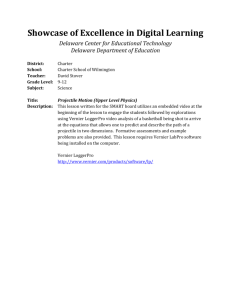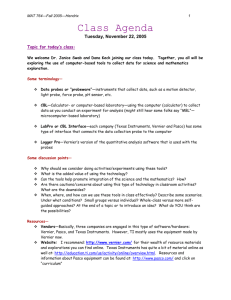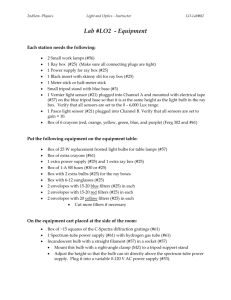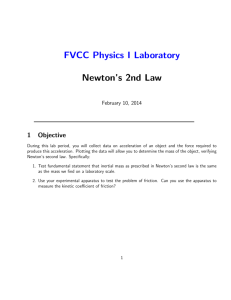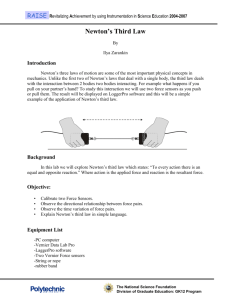Workshop Physics: Teaching Introductory Physics w/o Lectures
advertisement
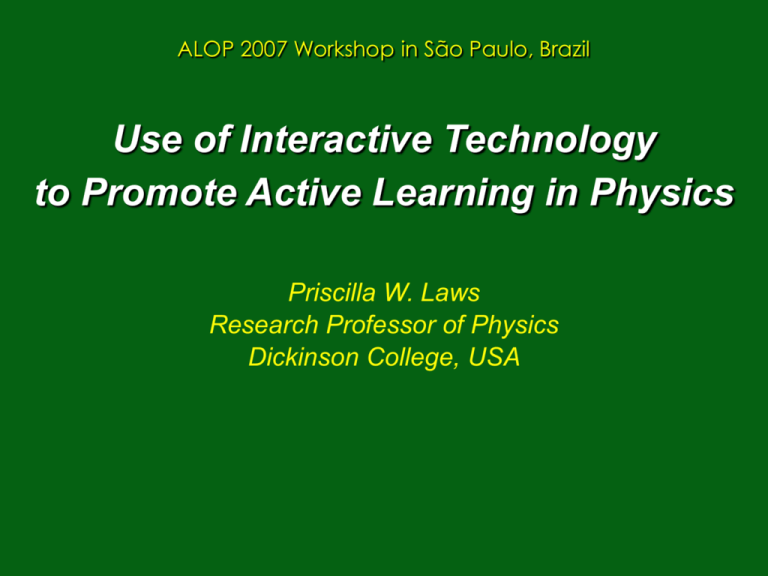
ALOP 2007 Workshop in São Paulo, Brazil Use of Interactive Technology to Promote Active Learning in Physics Priscilla W. Laws Research Professor of Physics Dickinson College, USA Activity Based Physics Combining Physics Education Research (PER) with computer tools to enhance learning in introductory courses ABP Group* Pat Cooney Maxine Willis Karen Cummings John Garrett Priscilla Laws David Jackson David Sokoloff Scott Franklin E.F. Redish Kerry Browne Ron Thornton Bob Teese * Supported off and on since 1986 by : National Science Foundation (USA) U.S. Department of Education (FIPSE) The Charles A. Dana Foundation ABP Group Activities Curriculum development Apparatus Design Computer Hardware & Software Design Physics Education Research Dissemination Activity Based Learning Environment Students construct knowledge from their own observations and peer discussions Students are challenged to compare predictions (based on their beliefs) to their own observations Students change their beliefs when confronted by differences between their initial beliefs and their own observations and experiments Instructor is a guide rather than an authority Using Computers Computer-Assisted Data Acquisition Hardware (CADA) Interface to USB Port on Computer Motion Detector Temperature Sensor Force Sensor * Vernier Software & Technology (www.vernier.com) ** PASCO scientific (www. pasco.com) Computer-Assisted Data Acquisition Software Collect Data from one or moreInterface sensors in “real to USB Port on time” Position Sound waves Motion Detector Temperature Magnetic Field Pressure Temperature Sensor Current and Voltage And many more Computer Insert a video and analyze positions on each frame Force Sensor * Vernier Software & Technology (www.vernier.com) ** PASCO scientific (www. pasco.com) An Example of CADA The Ultrasonic Motion Detector Computer Assisted Data Acquisition & Analysis Tools (CADAA) Learning Kinematics with an ultrasonic Motion Detector first by walking and then by observing the motions of low friction carts with attached fans Computer Assisted Data Acquisition & Analysis Tools (CADAA) Learning Kinematics with an ultrasonic Motion Detector first by walking and then by observing the motions of low friction carts with attached fans Open Kinematics.cmbl file Video Capture & Analysis Software Capture Software: LoggerPro or VideoPoint Capture Demonstration of LoggerPro Video Tools 1. Capture 2. Analysis Open Movie Capture and Analysis Why Newton’s Laws Are Hard to Teach the 1st law is unbelievable the 2nd law is incomprehensible the 3rd law is mere religious incantation –Jon Ogborn How Students Use Computer Tools to Understand Newton’s Law Newton’s First Law Computer Software Use the LoggerPro Software with either: A motion detector or Video capture and analysis Box on carpet Cart on Track Verifying Newton’s 1st Law by Inductive Reason and Experiments Newton’s Second Law Relate Force and Acceleration by Using a Motion Detector & Force Sensor Wireless Force & Acceleration Sensor Computer Assisted Data Acquisition & Analysis Tools (CADAA) Newton’s Second Law using a Force Sensor & Motion Detector (or Accelerometer) Open Fvs.A.cmbl Newton’s Third Law Computer Assisted Data Acquisition & Analysis Tools (CADAA) Verify Newton’s Third Law using Remote Force Sensors Open Car-Truck_Synch2.mov Open Run2_CarTruckData&Photos.cmbl Our Philosophy of Computer Use Flexible tools to explore and model the real world through direct investigation Transferable computer skills Not used as a tutorial device Simulations only used if real experience is inaccessible Evaluating Student Learning Conceptual Evaluations The Force Motion Concept Evaluation (FMCE) The Heat and Temperature Concept Evaluation (HTCE) The Light and Optics Concept Evaluation (LOCE) The Electric Circuits Concept Evaluation (ECCE) The Mathematical Modeling Concept Evaluation (MMCE) The Vector Evaluation Test (VET) http://physics.dickinson.edu/~wp_web/wp_resour ces/wp_assessment.html The Force & Motion Conceptual Evaluation (FMCE) Results of Pre & Post Testing using Activity Based Physics Curricula Traditional Instruction FMCE Results Force & Motion Conceptual Evaluation 100 % Students Giving Newtonian Answers 90 80 University of Oregon ‘89- ‘ 90 N = 240 students 70 60 Pre Test Post Test 50 40 30 20 10 0 Natural Language Graphical Evaluation Coin Toss Cart on Ramp RealTime Physics FMCE Results University of Oregon % Students Giving Newtonian Answers Pre Test NC (N = 240, '89-'91) After RTP Labs NC & C (N = 630, '92-'94) 100 90 80 70 60 50 40 30 20 10 0 Natural Language Graphical Evaluation Coin Toss Cart on Ramp Very New Products 1. LabQuest (Vernier Software & Technology 2. Classroom Spectrometry 3. The $100 USD Computer: One Laptop Per Child (OLPC) Vernier Software & Technology www.vernier.com • A hand held device • Screen can be seen outdoors • Compatable with 30 or more Vernier Sensors • Data can be collected and analyzed immediately • Has 6 sensor inputs QuickTime™ and a TIFF (Uncompressed) decompressor are needed to see this picture. Screen can be seen outdoors Use as interface with a computer Transfer Data to a computer or memory stick Beer’s Law: Absorbance vs. Concentration for NiSO4 OLPC Under Development by Former MIT Media Lab Faculty Specifications LCD and Black & White displays at 200dpi (900x1200) Microphone & 3 USB Connectors Video Camera Wireless communication Runs 6 v. Battery (NiMH) Graphic Interface
